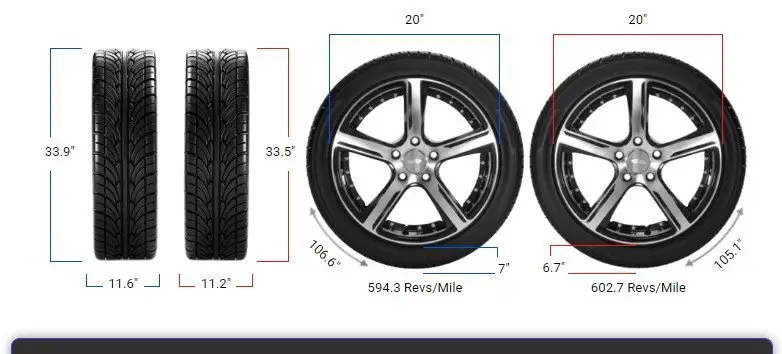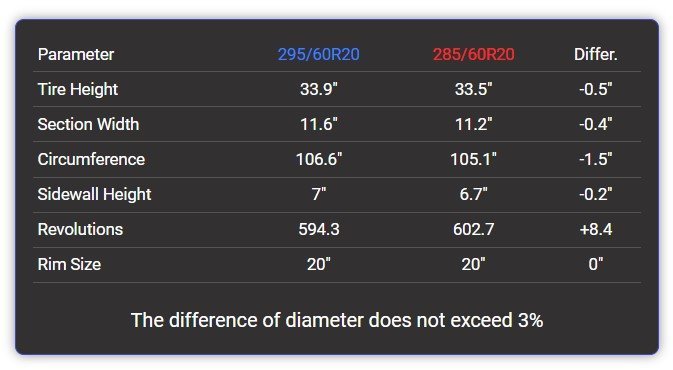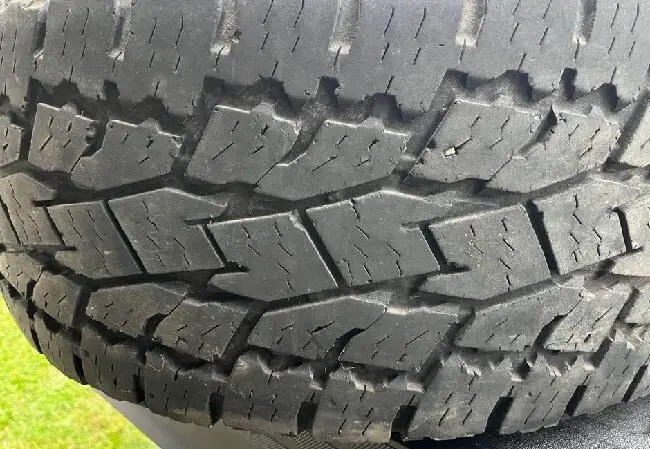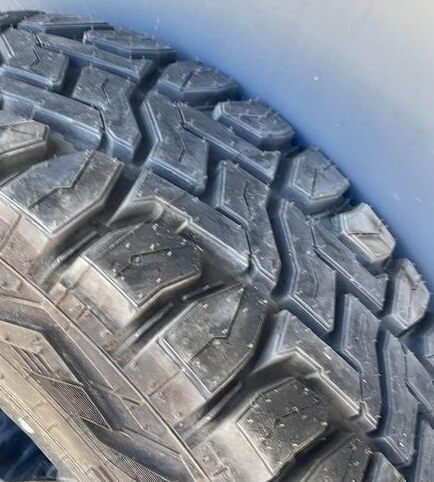Tire Size 295/60r20 vs 285/60r20

Changing from 295/60R20 to 285/60R20 tires is a relatively minor modification that falls within the acceptable 3% diameter difference range. While this switch may result in slight changes to your vehicle’s performance and appearance, the overall impact is likely to be minimal for most drivers.
- The diameter difference between 295/60R20 and 285/60R20 tires is only 1.4%, well within the acceptable range
- The width difference of 3.5% may result in a slightly narrower appearance and potentially improved fuel efficiency
- Speedometer readings will be minimally affected, with a 20 mph reading actually being 20.28 mph
295/60r20 vs 285/60r20 Table
The main difference between 295/60R20 and 285/60R20 tires lies in their width, with the 285/60R20 tires being 0.39 inches (10 mm) narrower than the 295/60R20 tires.

Fitment Guide
According to the data provided, the diameter difference between 295/60R20 and 285/60R20 tires is only 1.4%, which falls within the acceptable range of 3%.
This means that switching from 295/60R20 to 285/60R20 tires is a viable option without requiring significant modifications to your vehicle.
On-Road Impact
When driving on paved roads, the switch from 295/60R20 to 285/60R20 tires may result in several minor changes to your vehicle’s performance and handling.
- Ground Clearance: The slightly smaller diameter of the 285/60R20 tires may result in a minimal decrease in ground clearance, but this difference is unlikely to be noticeable in most driving situations.
- Gas Mileage: The narrower width of the 285/60R20 tires may lead to a slight improvement in fuel efficiency due to reduced rolling resistance. However, this change is likely to be minimal and may not be noticeable in everyday driving.
- Aesthetics: The narrower width of the 285/60R20 tires may give your vehicle a slightly different appearance, with a more slender profile. This change in aesthetics is subjective and depends on personal preference.
- Ride Comfort: The switch to 285/60R20 tires may result in a slightly firmer ride due to the reduced sidewall height. However, this difference is likely to be minimal and may not be noticeable to most drivers.
- Speedometer Accuracy: The speedometer reading will be minimally affected by the switch to 285/60R20 tires. At a 20 mph reading, your actual speed will be 20.28 mph, a difference of only 0.28 mph.

Off-Road Impact
If you use your vehicle for off-road adventures, the switch from 295/60R20 to 285/60R20 tires may have a slight impact on your vehicle’s performance.
- Traction: The narrower width of the 285/60R20 tires may result in a minor reduction in traction on loose surfaces like sand or mud. However, this difference is likely to be minimal and may not significantly affect your off-road experience.
- Durability & Wear: The overall durability and wear characteristics of the tires will depend more on the specific tire model and brand rather than the size difference between 295/60R20 and 285/60R20.
What is the Difference Between 285/60R20 and 295/60R20?
The main difference between 285/60R20 and 295/60R20 tires lies in their width. The 295/60R20 tire is 0.39 inches (10 mm) wider than the 285/60R20 tire.
The wider 295/60R20 tire may provide better traction and stability, especially in wet or off-road conditions, but may also result in a slightly firmer ride and increased rolling resistance, which could impact fuel efficiency.

Can I Use 295/60R20 Instead of 285/60R20?
Yes, you can use 295/60R20 tires instead of 285/60R20 tires. The overall diameter difference between these two tire sizes is approximately 0.47 inches (12 mm) or 1.4%, which is within the generally accepted 3% difference range.
This means that switching from 285/60R20 to 295/60R20 tires should not significantly affect your vehicle’s performance, speedometer accuracy, or fuel efficiency.
How Much Taller Is a 295/60R20 Tire Than a 285/60R20?
A 295/60R20 tire is approximately 0.47 inches (12 mm) taller than a 285/60R20 tire. The overall diameter of the 295/60R20 tire is 33.94 inches (862 mm), while the overall diameter of the 285/60R20 tire is 33.46 inches (850 mm).
This difference in height is relatively minor and should not significantly impact the vehicle’s ground clearance or handling.
How Much Wider is a 295/60R20 Tire Than a 285/60R20?
A 295/60R20 tire is 0.39 inches (10 mm) wider than a 285/60R20 tire. The width of the 295/60R20 tire is 11.61 inches (295 mm), while the width of the 285/60R20 tire is 11.22 inches (285 mm).
This difference in width may result in a slightly different appearance and could potentially affect the vehicle’s handling, traction, and ride comfort.
Our Observations
After analyzing the data and considering the potential effects of switching from 295/60R20 to 285/60R20 tires, we believe that for most drivers, the differences will be minimal and unlikely to significantly impact their driving experience.
The 1.4% diameter difference and 3.5% width difference fall within the acceptable range and should not cause any major issues with vehicle performance or handling.
However, it’s essential to keep in mind that individual preferences and specific driving conditions may influence how noticeable these changes are.
Overall, if you’re considering switching from 295/60R20 to 285/60R20 tires, you can do so with confidence, knowing that the differences are relatively minor and should not adversely affect your vehicle’s performance or safety.

Meet Caitlin McCormack, a Tire Size Expert and Blogger Passionate About Everything Related to Tires. With Years of Experience in the Tire Industry, Caitlin Has Become an Expert in Tire Sizes and Their Impact on Vehicle Performance.
